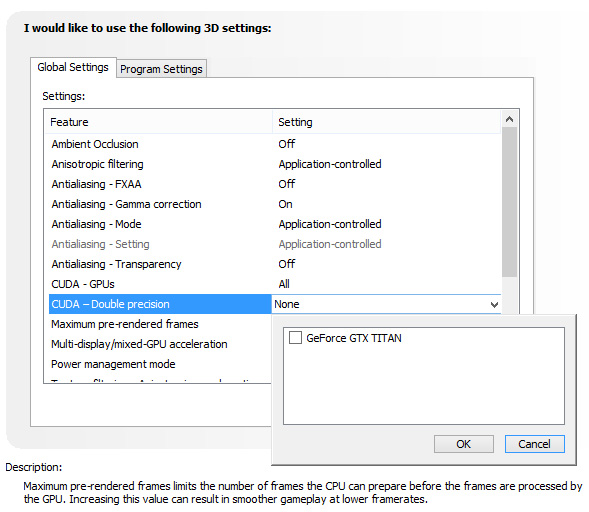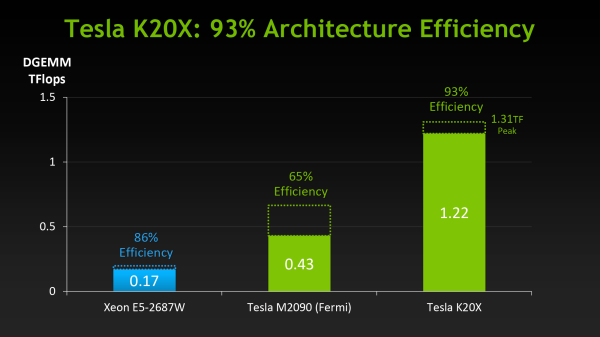NVIDIA's GeForce GTX Titan, Part 1: Titan For Gaming, Titan For Compute
by Ryan Smith on February 19, 2013 9:01 AM ESTTitan For Compute
Titan, as we briefly mentioned before, is not just a consumer graphics card. It is also a compute card and will essentially serve as NVIDIA’s entry-level compute product for both the consumer and pro-sumer markets.
The key enabler for this is that Titan, unlike any consumer GeForce card before it, will feature full FP64 performance, allowing GK110’s FP64 potency to shine through. Previous NVIDIA cards either had very few FP64 CUDA cores (GTX 680) or artificial FP64 performance restrictions (GTX 580), in order to maintain the market segmentation between cheap GeForce cards and more expensive Quadro and Tesla cards. NVIDIA will still be maintaining this segmentation, but in new ways.
| NVIDIA GPU Comparison | ||||||
| Fermi GF100 | Fermi GF104 | Kepler GK104 | Kepler GK110 | |||
| Compute Capability | 2.0 | 2.1 | 3.0 | 3.5 | ||
| Threads/Warp | 32 | 32 | 32 | 32 | ||
| Max Warps/SM(X) | 48 | 48 | 64 | 64 | ||
| Max Threads/SM(X) | 1536 | 1536 | 2048 | 2048 | ||
| Register File | 32,768 | 32,768 | 65,536 | 65,536 | ||
| Max Registers/Thread | 63 | 63 | 63 | 255 | ||
| Shared Mem Config |
16K 48K |
16K 48K |
16K 32K 48K |
16K 32K 48K |
||
| Hyper-Q | No | No | No | Yes | ||
| Dynamic Parallelism | No | No | No | Yes | ||
We’ve covered GK110’s compute features in-depth in our look at Tesla K20 so we won’t go into great detail here, but as a reminder, along with beefing up their functional unit counts relative to GF100, GK110 has several feature improvements to further improve compute efficiency and the resulting performance. Relative to the GK104 based GTX 680, Titan brings with it a much greater number of registers per thread (255), not to mention a number of new instructions such as the shuffle instructions to allow intra-warp data sharing. But most of all, Titan brings with it NVIDIA’s Kepler marquee compute features: HyperQ and Dynamic Parallelism, which allows for a greater number of hardware work queues and for kernels to dispatch other kernels respectively.
With that said, there is a catch. NVIDIA has stripped GK110 of some of its reliability and scalability features in order to maintain the Tesla/GeForce market segmentation, which means Titan for compute is left for small-scale workloads that don’t require Tesla’s greater reliability. ECC memory protection is of course gone, but also gone is HyperQ’s MPI functionality, and GPU Direct’s RDMA functionality (DMA between the GPU and 3rd party PCIe devices). Other than ECC these are much more market-specific features, and as such while Titan is effectively locked out of highly distributed scenarios, this should be fine for smaller workloads.
There is one other quirk to Titan’s FP64 implementation however, and that is that it needs to be enabled (or rather, uncapped). By default Titan is actually restricted to 1/24 performance, like the GTX 680 before it. Doing so allows NVIDIA to keep clockspeeds higher and power consumption lower, knowing the apparently power-hungry FP64 CUDA cores can’t run at full load on top of all of the other functional units that can be active at the same time. Consequently NVIDIA makes FP64 an enable/disable option in their control panel, controlling whether FP64 is operating at full speed (1/3 FP32), or reduced speed (1/24 FP32).

The penalty for enabling full speed FP64 mode is that NVIDIA has to reduce clockspeeds to keep everything within spec. For our sample card this manifests itself as GPU Boost being disabled, forcing our card to run at 837MHz (or lower) at all times. And while we haven't seen it first-hand, NVIDIA tells us that in particularly TDP constrained situations Titan can drop below the base clock to as low as 725MHz. This is why NVIDIA’s official compute performance figures are 4.5 TFLOPS for FP32, but only 1.3 TFLOPS for FP64. The former is calculated around the base clock speed, while the latter is calculated around the worst case clockspeed of 725MHz. The actual execution rate is still 1/3.
Unfortunately there’s not much else we can say about compute performance at this time, as to go much farther than this requires being able to reference specific performance figures. So we’ll follow this up on Thursday with those figures and a performance analysis.











157 Comments
View All Comments
Olaf van der Spek - Tuesday, February 19, 2013 - link
Who cares about your pair of cards? Nobody but you!Iketh - Tuesday, February 19, 2013 - link
lol hater!CeriseCogburn - Sunday, February 24, 2013 - link
As compared to the crawl into the street and stone yourself missive you throw in another post ? LOLYou won the hate war bub !
I thought the gentleman owning the two 7950's made a very decent comment.
Yes it's shocking coming from someone with 2 amd cards, but for once, it occurred.
chizow - Tuesday, February 19, 2013 - link
This is much worst than the Ultra imo, at least in the case of the 8800GTX/Ultra, the performance at least somewhat justified the price relative to the rest of the market. We are somewhat spoiled by the bevy of card releases in recent years, but that's also the curse of the 680 and now Titan, the performance difference is nowhere close to the increase in price tag.CeriseCogburn - Sunday, February 24, 2013 - link
You're NUTS to pretend you deserve 1 to 1 price to perf pricing on up the line, or that it is even a standard or usual expected measured outcome.What you do have is years now of idiot web articles and postings from insanely focused miniscule minded scrooge like weirdos futzing around dicing up beans to fill web space. So now your brain is fried. FPS is all the drool cup can visibly contain.
Congratulations on the complete brainwashing. When you screamed 100% in the prior threads, it was found to be 20%, 30%, etc. outlying 40%.
Facts don't matter, all the bang for the buck historical fantasy BS in your gourd, does.
joqqy - Wednesday, February 20, 2013 - link
I'll wait until price drops, quite content with what I have now.CeriseCogburn - Sunday, February 24, 2013 - link
Since you spent $550, you could spend a grand.I accept your notional decision, but it is not out of your price range, you are after all running 2x #2 flagships.
In fact yours is the first and ONLY reasonable pricing comment (complaint) in the entire thread.
Congratulations for that. Appreciate it. Happy gaming to you.
Deo Domuique - Friday, March 8, 2013 - link
I strongly believe, currently the best setup one could have is what you have...2x 7950 the most bang for your buck! 2 great cards with great price... Although, I'm no fan of Crossfire or Sli. Still, even one 7950 it still holds the best spot in my mind.
sensiballfeel - Tuesday, February 19, 2013 - link
$1000 for a card slower than a GTX 690?Running two 580s for years now and skipped 680 for being too slow expecting something else in the pipeline.This is it and NvidiA wants to double the price to $1000?
Nvidia has lost their mind.Good card,the price is beyond ridiculous.Nice try nvidia,but no thanks.
Menty - Tuesday, February 19, 2013 - link
Meh, it's a single card rather than an SLI-on-a-stick card. That makes it better, in my book.